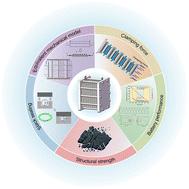通过等效力学模型实现液流电池组的稳定可靠装配
IF 9.5
2区 材料科学
Q1 CHEMISTRY, PHYSICAL
引用次数: 0
摘要
向低碳社会的过渡需要高效的能量转换和存储设备。氧化还原液流电池是很有前途的候选者;然而,他们的堆栈的能源效率(EE)仍然受到限制,其中一个主要原因是次优组装力。装配力不足会增大元件间的接触电阻,增大欧姆损耗。反之,过大的装配力会过度压缩多孔电极,降低有效渗透率,显著提高泵送损耗。这两种情况都会对堆叠的能量转换效率产生不利影响。此外,装配力不足可能导致密封失效和电解液泄漏,而力过大则会破坏电池的结构完整性,并可能对内部组件造成伤害。此外,对堆栈大小或组装材料的任何修改都需要完全重复此过程,从而进一步增加了复杂性和资源需求。尽管对液流电池装配力优化影响的系统研究具有重要意义,但在现有的研究中却在很大程度上被忽视。为了克服这些挑战,本研究开发了RFB堆的等效力学模型,有助于确定堆组装过程中的最佳装配力。这种优化考虑了电化学性能、密封完整性和单个组件的结构强度。结果表明,将拧紧力矩保持在计算范围内,可以保证RFB堆的密封完整性。此外,在电流密度为100 mA cm - 2的循环操作中,堆叠的库仑效率达到95%,EE达到84%。这些发现证实了所提出方法的有效性和实用性,可以实现精确可靠的RFB堆叠组装,确保电池在保持高EE的同时稳定运行。本文章由计算机程序翻译,如有差异,请以英文原文为准。

Achieving stable and reliable assembly of flow battery stacks through equivalent mechanical models
The transition to a low-carbon society demands energy conversion and storage devices with high efficiency. Redox flow batteries are promising candidates; however, their stacks' energy efficiency (EE) remains constrained, and one of the main reasons is the sub-optimal assembly force. Inadequate assembly force can elevate contact resistance among components, and heighten ohmic losses. Conversely, excessive assembly force can overly compress porous electrodes, reduce effective permeability and notably elevate pumping loss. Both scenarios adversely impact the stack's energy conversion efficiency. Moreover, insufficient assembly force may lead to seal failure and electrolyte leakage, while excessive force can jeopardize the battery's structural integrity and potentially harm internal components. Furthermore, any modifications to the stack size or assembly materials necessitate a complete repetition of this process, further increasing the complexity and resource demands. Despite its critical significance, the systematic investigation of the impacts of assembly force optimization in flow batteries remains largely neglected within existing research. To overcome these challenges, this study develops an equivalent mechanical model for RFB stacks, facilitating the determination of the optimal assembly force during stack assembly. This optimization accounts for electrochemical performance, sealing integrity, and the structural strength of individual components. Results indicated that maintaining the tightening torque within the calculated range ensured the sealing integrity of the RFB stack. Furthermore, the stack achieved a coulombic efficiency of 95% and an EE of 84% during cycling operations at a current density of 100 mA cm−2. These findings confirm the effectiveness and practicality of the proposed method for achieving precise and reliable assembly of RFB stacks, ensuring that the battery operates stably while maintaining high EE.
求助全文
通过发布文献求助,成功后即可免费获取论文全文。
去求助
来源期刊

Journal of Materials Chemistry A
CHEMISTRY, PHYSICAL-ENERGY & FUELS
CiteScore
19.50
自引率
5.00%
发文量
1892
审稿时长
1.5 months
期刊介绍:
The Journal of Materials Chemistry A, B & C covers a wide range of high-quality studies in the field of materials chemistry, with each section focusing on specific applications of the materials studied. Journal of Materials Chemistry A emphasizes applications in energy and sustainability, including topics such as artificial photosynthesis, batteries, and fuel cells. Journal of Materials Chemistry B focuses on applications in biology and medicine, while Journal of Materials Chemistry C covers applications in optical, magnetic, and electronic devices. Example topic areas within the scope of Journal of Materials Chemistry A include catalysis, green/sustainable materials, sensors, and water treatment, among others.
 求助内容:
求助内容: 应助结果提醒方式:
应助结果提醒方式:


